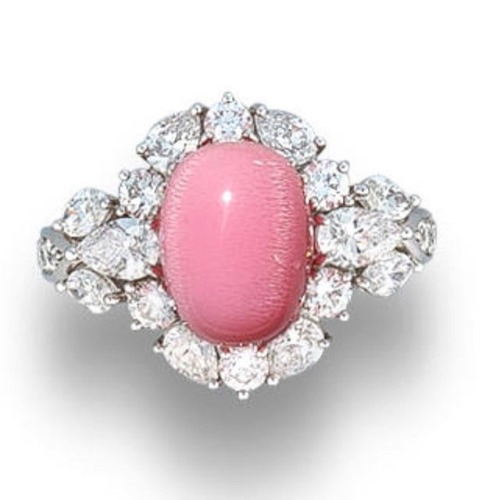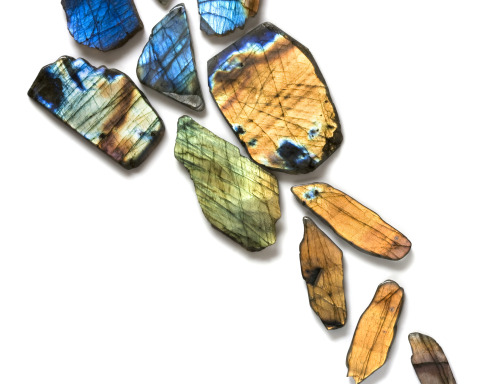#gemology
•The name ruby comes from the Latin word ruber, which means “red”.
•Ruby is the birthstone for July and the gem for the 15th (in the U.S.) and 40th anniversaries.
•Ruby is the most valuable variety of the corundum mineral species.
•Chromium is the trace element that causes ruby’s red, which ranges from an orangey red to a purplish red.
•The strength of ruby’s red depends on how much chromium is present—the more chromium, the stronger the red.
….
The Carmen Lúcia Ruby. The 23.1-carat Burmese ruby, set in a platinum ring with diamonds was donated to the Smithsonian by businessman and philanthropist Peter Buck in memory of his wife Carmen Lúcia. The stone was mined from the famous Mogok region of Burma in the 1930s. While sapphire, emerald and diamond gems weighing hundreds of carats exist, high quality Burmese rubies larger than 20 carats are incredibly rare.
Post link
Non nacreous pearl from the “spiny oyster”:
6.97 ct bicolored white and pink Spondylus pearl with a beautiful reflective blue coloration a flame structure when viewed in certain directions under a single white light source. Photo by Robert Weldon/GIA.
The spiny oyster shells occur in reds, oranges and purples depending on their diet. Because of their vibrant colors spiny oyster shells are often used in jewelry; especially Native American jewelry.
Post link
Shelled mollusks produce a “pearl” when a microscopic irritant is trapped within its mantle folds. The mollusk creates a pearl sac to seal off the irritation. This is a part of the mollusk’s defense mechanism against a potentially threatening irritant such as a parasite inside the shell, or an attack from outside that injures the mantle tissue.
The mollusk’s mantle deposits layers of calcium carbonate in the form of the mineral aragonite or a mixture of aragonite and calcite that are held together by an organic horn-like compound called conchiolin. This combination is called nacre. Natural pearls are nearly 100% nacre (calcium carbonate and conchiolin). This secretion process is repeated many times, eventually producing a pearl.
Natural pearls are quite rare. This means that hundreds of pearl oysters or mussels must be gathered and opened just to find even one wild pearl. For this reason pearls were able to fetch extraordinary prices in the past. With the advent of cultured pearls there was a dip in the value of pearls as a reaction to the fact that they were now available to more than just the elite classes. In recent years there has been a steady increase in the value of natural pearls as buyers are drawn to the rarity of natural pearls once again.
“Gem” quality natural pearls are still very rare. Values are determined by size, shape, color, quality of surface, orient and luster.
*A pair of belle époque natural pearl and diamond pendent earrings, circa 1910
Sold by Bonhams in 2006.*
Post link
•Alexandrite is a variety of chrysoberyl know for its dramatic color change from purplish-red under incandescent light to bluish-green in daylight or fluorescent light.
•Impurities of chromium cause alexandrite to transmit red and green light equally well.
•The stone is named after Czar Alexander II.
•The original mining location for alexandrite is Russia, however, gems have also been found in Brazil, Sri Lanka, Tanzania, Madagascar, Zimbabwe, India, and Burma.
•Alexandrite over 2 carats is considered large. Stones over 5 carats are extremely rare.
*The 17.08-carat Whitney Alexandrite is a raspberry color under incandescent light and a teal (green-blue) color under daylight. It is one of the finest known alexandrites from the Hematita Mine in Minas Gerais, Brazil. The stone was gifted to the Smithsonian in 2009 by Coralyn Wright Whitney and is on display at the National Museum of Natural History.*
•Feldspars are the most diverse and widespread minerals in the earth’s crust.
•Moonstone is the most familiar gem-quality member of the feldspar group.
•Moonstone is a part of the feldspar group, and is a variety of the species orthoclase within that group.
•Moonstone is a composite of two feldspar minerals, orthoclase and albite. After the orthoclase and albite have come together they cool and separate into alternating layers that are stacked on each other.
•Moonstone is known for having an ethereal misty glowing look. This phenomenon is called adularescence.
•Adurlarescence is occurs when light falls between the stacked layers of orthoclase and albite and scatters it.
•Rainbow moonstone has a multicolored adularescence over a light bodycolor. However it is not actually moonstone. It is a variety of labradorite (often from Madagascar) and rainbow moonstone is a trade misnomer.
*The necklace features moonstones and labradorite set in silver. It was made by Danish Designer Georg Jensen between 1915-1927 and currently resides at the Victoria & Albert Museum.*
Post link
•The hard clams (Mercenaria mercenaria) or Quahogs are an edible marine bivalve mollusk, also known as a round clam, or hard-shell (or hard-shelled) clam.
• The clams are native to the Atlantic shores of North America from Canada to Georgia, especially on the coast of the New England states, and can also be found along California’s Pacific coast.
•Quahogs sometimes produce non-nacreous porcelain-like pearls.
•Quahog pearls occur in a variety of colors ranging from white to brown and from faint pinkish purple to dark purple.
•Like many other natural pearls, quahog pearls are rarely spherical. Button shapes with flat bases are the most common.
•It is estimated that only 1 in 100,000 Quahog clams actually produce a pearl of any kind.
Suite of 45 Quahog Pearls, from the Coastal waters of the North Atlantic. Sold at Bonhams in 2014
Post link
•Melo “pearls” are non nacreous calcareous concretion.
•They come from the Indian volute (melo melo snail). A very large sea snail (marine gastropod mollusc) native to Southeast Asia, from Burma, Thailand and Malaysia, to the South China Sea and the Philippines.
•This snail is used for food by local fishermen and the shells are also often used as decoration, or as scoops.
•The pearls have a range of colors, with the most prized being an intense orange.
•Like conch pearls high quality melo pearls exhibit a flame-like structure.
•Also similar to conch pearls melo pearls are rare and are prized among collectors.
Melo pearl and garnet earrings by Hemmerle
Post link
•Conch “pearls” are calcareous concretions produced by the Queen conch mollusk, Strombus gigas, which is found in various areas of the Caribbean.
•All Conch pearls are natural; attempts to culture them have failed.
•Conch pearls are one of the rarest pearls in the world.
•The odds of finding an acceptable pearl are one in every 10,000 – 20,000 shells collected.
•The most coveted color is a “flamingo pink”.
•The highest quality Conch pearls are characterised by a distinctive ‘flame structure’. This give the appearance of “a fire burning on the surface”.
Conch pearl and diamond ring created by Mikimoto. Sold at auction in 2012.
Post link
Jardin: the French word for ‘garden’. This term is often used in the Gemstone trade to romantically describe mossy or garden looking inclusions that are commonly found in emeralds.
Post link
Close up of Botswana agate with its brown earthy color and beautiful white agate lines.
https://www.etsy.com/shop/UnearthedGemstones?search_query=botswana
Post link













